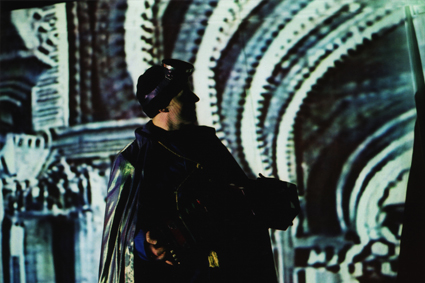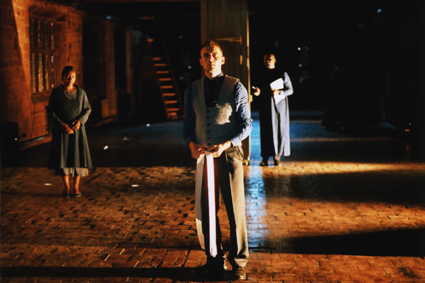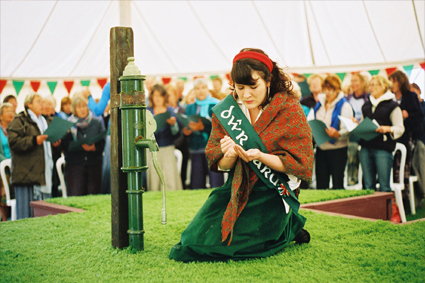The Talking Birds Guide to Theatre of Place
Site-specific performance, an increasingly popular genre of work amongst both artists and audiences, brings unique challenges, amongst them being double booked with heffers. Talking Birds has made a speciality of transforming unusual spaces, which have included a decommissioned hospital, a giant underground car-park, a 14th century monastery and the wreck of a Victorian variety theatre. Each new site is approached on its own terms, and with a careful tread – not only because of what the previous four legged tenants might have left in their wake.
Lesson 1: Let the Site Sell the Show
Three Doctors (2006) was commissioned to mark the closure of a much-loved city-centre “cottage” hospital in Coventry and relocation of health services to a new “super hospital” several miles out. The move had generated much local controversy, and we were very aware of working in a building which aroused mixed feelings and held strong associations for the staff and members of the public who would form our audience.
Our partner in the project was the Centre for the History of Medicine at the University of Warwick, who had catalogued a vast number of medical instruments found in the building – some of whose function had long since left the collective medical memory – and had conducted interviews with former staff and patients, which formed the basis of the text for our show.

at Coventry & Warwickshire Hospital
What we hadn’t predicted was just how many people would want to take a last look at this battered hospital before it closed – our 10 promenade performances could have been repeated threefold and still not accommodated everyone who wanted to see it. In truth, the building was the ageing star they had come to see, and what we provided was a useful excuse. Though the degree of emotional outpouring at the end of each “tour” – hardened health professionals included – suggested we had done the right thing in the right place, at the right time.
The diverse and largely unfamiliar audience we’ve had at such events suggests that those elusive “new audiences”, while unlikely perhaps to be drawn into a studio theatre to experience our work, will be tripping over themselves to see what the hell we’re doing in a place they are curious about, on a patch of territory they are in some way attached to. And those audiences do follow us to the next place we go – such as the 80 year old who, having seen Three Doctors, became a participant in Market Forces (2007), the company’s residency at Coventry’s iconic circular indoor market (where the recurring question “what are you selling?” threw the audience/artist “transaction” into interesting relief). Others are lured into the bricks and mortar of a conventional theatre to see our work there as a result.
Lesson 2: Let the Site Steal the Show
A resonant place may tell you all you need to know about what to do there. Hearing the epic 20 second reverberation of a car door slamming in the South Bay Underground car-park in Scarborough immediately suggested that the music/sound design for Wanderlust (2002) had to harness and use the extreme acoustic. If it came to an acoustical fist-fight, the venue was going to win hands down and upstage the show into unintelligibility. But treated with care what it provided was a majestic echo chamber which could make a squeeze box sound like a cathedral organ.
The historical resonances can be even more unexpected – the parking attendant letting us into this unpromising concrete bunker, buried into the seafront, mentioned that, as a boy, he had come to “Galaland”, an arcade that the car park replaced in the 1960s. Digging in the local history archives revealed astonishing pictures of Moroccan-style arches, which seemed incongruously elaborate architecture for an amusement arcade until further investigation revealed the original life of the building – as Scarborough Aquarium, designed by maverick architect Eugenius Birch, best known for his seaside piers.
Peeling back the historical layers of a place often seems to provide the key to what we are doing there – and in this case gave us the denouement of the show. At the point that the full extent of the space was finally revealed to the audience, we used projections to transform it back into an aquarium (tip: don’t let the site steal the show too early on – save the dramatic reveal for the 2nd half). What’s more, its recent history as a car-park gave us a Pay and Display machine which, modified with the aid of a council official, acted as a handy box office.
Lesson 3: Consider the Needs of your Audience
We faced a formative dilemma in the case of Solid Blue (2002) where the stunning theatrical possibilities of a 70 metre long room on the first floor of a 14th century monastery building, which had been closed to the public for decades, were unfortunately combined with a very, very broken lift and therefore the prospect of a performance which would be inaccessible to anyone who couldn’t make it up the stairs.
Work in unusual places is subject to the same legislation as conventional venues, including the Disability Discrimination Act which requires that “reasonable adjustments” are made to make your product or service available to people with a wide range of access needs. Most conventional venues will have made the necessary physical modifications to their buildings, and may have access technology wired in. Interesting old or semi-derelict sites may have neither.
The creative solution in the monastery, cooked up with help from an exceedingly supportive local authority access officer, was to provide an alternative view of the performance downstairs in the evocative cloister space, via a video and sound link, enhanced by visits from the three actors when they were “offstage” for the upstairs audience. It was relatively inexpensive to carry out with the aid of technicians already working on the gig, and, though not a substitute for a more comprehensive physical solution given the time and resources, the feedback from those who watched downstairs was that they got a good, and slightly exclusive, experience.
This has informed our choice of sites since, and made us aware that subtle, inexpensive adjustments, with the benefit of an expert’s guidance, can make the experience of site-specific work for disabled audience members better. The same carpenter who is building the set can also construct ramps/handrails. The route of a promenade performance, with a bit of forward thinking, can be geared to people whose mobility is restricted and alternative routes planned in where necessary. Where conventional audio description is not an option (though technically, if not financially, it almost always is), subtle additions by the writer to give key visual information through the script can enhance the performance for someone with a visual impairment.
As soon as accessibility is regarded as a subtle art, rather than a legislative burden, it becomes an interesting (as well as necessary) part of the challenge presented by every new building or site and its corresponding show, and the creative solutions it provokes often benefit the whole audience.
Lesson 4: The Locals Are Your Asset
If the building you are working in is still, or recently has been, in use, the people that live/work there are often a crucial repository of material. Local historians may fill you in on the juicy bits that do not appear in the official records. Performers from the local community will not only bring their talent and energy to the production, but also their families and friends to see the show. Be prepared for a degree of healthy skepticism to be overcome: on one occasion, the receptionist of a large local authority building where we were artists in residence greeted us with the hope that we wouldn’t be bringing “Tracie Ullman’s bed” into the reception area. We soon found she was a key conduit of useful information within the organization, and finally won over, became a vocal proselytizer for the finished work.
Lesson 5: Let the Site Find the Money
Artists are notoriously adept at being inventive with limited means, but in a time when economic realities will impact on how productions are resourced, it may be counter-intuitive to argue for a genre which by its nature is often a one-off, and can seldom be justified in terms of box office returns. However, being flexible and open to working outside the black box can lead to partnerships with organisations outside of the arts – whether heritage bodies or history/sociology-related research departments, developers with temporarily empty properties, or local authorities – and, correspondingly, such partnerships can give access to resources beyond arts funding.
There can be other solutions to the “one-off” dilemma, such as a “site-responsive” approach, where an existing show/idea is tailored to different locations, making it a more transferable asset. In the case of Dŵr Caru (Sweet Water) (2009) the idea of site-specificity was itself at play in a show about disputed borders, which moved in a tent to several English-Welsh border locations and so was simultaneously site-specific and tourable. And, arguably, more and more examples of Theatre of Place are being commissioned by Rep theatres to go inside and outside their buildings, embedding their work in the communities they serve, and attracting very healthy houses.
Lesson 6: We’re a Blip on the Timeline
We’re constantly aware, working in places with a history – particularly when we are there at a time of change for that building or community – that what we do there will be a blip on a timeline, whether 50, or 600, years long. This can be a usefully sobering thought when entering a new space for the first time. But, we’d argue, a successful Theatre of Place, where site and performance meet, requires humility without reverence, as ours is not the business of giving guided tours. If you’re going to make a blip, make it a big, funny and transformative one.
Derek Nisbet, Composer/Joint Artistic Director, Talking Birds
Commissioned for the British Performing Arts Yearbook 2011





